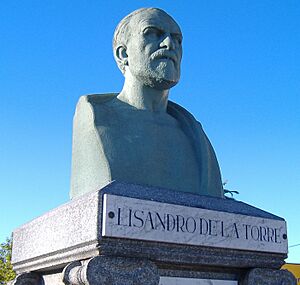Lisandro de la Torre facts for kids
Quick facts for kids
Lisandro de la Torre
|
|
|---|---|
 |
|
| National Senator | |
| In office 20 February 1920 – 5 January 1937 |
|
| Constituency | Santa Fe |
| National Deputy | |
| In office 29 April 1922 – 29 April 1926 |
|
| Constituency | Santa Fe |
| In office 29 April 1912 – 29 April 1916 |
|
| Constituency | Santa Fe |
| Provincial Deputy of Santa Fe | |
| In office 27 March 1911 – 1 June 1912 |
|
| Constituency | San Lorenzo Department |
| Personal details | |
| Born | 6 December 1868 Rosario, Argentina |
| Died | 5 January 1939 (aged 70) Buenos Aires, Argentina |
| Cause of death | ... by firearm |
| Political party | Radical Civic Union (1891–1897) Democratic Progressive Party (1914–1939) |
| Alma mater | University of Buenos Aires |
Lisandro de la Torre (born December 6, 1868 – died January 5, 1939) was an important Argentine politician from Rosario, Santa Fe. He was known for his strong sense of right and wrong in politics. He served as a national deputy and later as a senator.
He was also a great speaker and the person who started the Democratic Progressive Party in 1914. Lisandro de la Torre tried to become President twice, in 1916 and 1931.
He became a lawyer in 1890. His ideas about how local governments (like municipalities and communes) should work helped shape the idea of municipal autonomy in Argentina. This idea was later added to the Argentine Constitution in 1994. In 1898, he started a newspaper called La República (which means "The Republic") in Rosario.
Contents
Lisandro de la Torre's Early Political Life
Lisandro de la Torre first joined the Radical Civic Union (UCR) party, led by Leandro Alem. However, he left the party in 1897 because he disagreed with the new leader, Hipólito Yrigoyen.
Later, in 1908, he helped create a local political group called the Southern League (Liga del Sur). In 1911, he was chosen to represent the San Lorenzo Department in the provincial government. The next year, in 1912, he became a representative for Santa Fe in the lower house of the National Congress, still representing the Southern League.
On December 14, 1914, de la Torre helped form the Democratic Progressive Party (PDP). This new party chose him as their candidate for president in the 1916 elections. However, the PDP lost to the UCR's candidate, Hipólito Yrigoyen. De la Torre also lost the 1919 elections when he ran for senator representing Buenos Aires.
In 1921, de la Torre's PDP helped create a new constitution for Santa Fe province. This constitution was seen as very modern and forward-thinking for its time. But it was not approved by the Radical governor, Enrique Mosca.
De la Torre was elected as a national representative for Santa Fe again in 1922. In 1925, he announced that he was leaving politics. In 1931, the PDP joined with the Democratic-Socialist Alliance. They chose De la Torre and Nicolás Repetto to run for president, but they were defeated by Agustín Pedro Justo and Julio Argentino Pascual Roca.
Work in the National Senate
In 1932, the PDP had a big win when Luciano Molinas became the governor of Santa Fe. At the same time, Lisandro de la Torre became a national senator for the Democratic Progressive Party.
In 1935, he started an important investigation into the meat trade. This investigation had been tried before by another member of his party, Julio Noble, but without success. During this investigation, a sad event happened: de la Torre's friend and fellow senator, Enzo Bordabehere, was killed. It is believed that the bullet that killed Bordabehere was meant for de la Torre. The province of Santa Fe was then put under federal control.
The investigation and debates were about laws that aimed to protect the prices of farm products like grains and beef. De la Torre and two government ministers had strong disagreements. This led to a formal challenge, like a duel. He accepted the challenge from Federico Pinedo, the Minister of Finance. However, he refused to duel with the Minister of Agriculture, Luis Duhau, because he did not consider Duhau a gentleman. In the duel, Pinedo shot to hit, but missed. De la Torre purposely missed, so no one was hurt. But they never became friends again. De la Torre remained a senator until 1937.
Lisandro de la Torre's Legacy
Historians believe that Lisandro de la Torre was very sad about Bordabehere's death. He also felt very disappointed with the corruption and unfairness in Argentine politics at that time. He passed away on January 5, 1939. His ashes are now in an urn, buried in the El Salvador Cemetery in Rosario.
The Dr. Julio Marc Provincial Historical Museum in Rosario has a special display. It shows a copy of de la Torre's home in Buenos Aires, complete with his original furniture.
A large meatpacking plant in Buenos Aires, famous for a big workers' protest in 1959, was named after him.
Today, a barrio (neighborhood) in the north-east of Rosario is named after him. This neighborhood, called Barrio Lisandro de la Torre (also known as Arroyito), is home to the Rosario Central football club. There is also a street in the southern part of Rosario and many other streets and avenues across Argentina that carry his name.
In 1984, a movie called Asesinato en el senado de la nación was made. It told the story of the events leading up to Enzo Bordabehere's death. In the movie, Lisandro de la Torre was played by Pepe Soriano, and the film was directed by Juan José Jusid.
See also
 In Spanish: Lisandro de la Torre para niños
In Spanish: Lisandro de la Torre para niños


